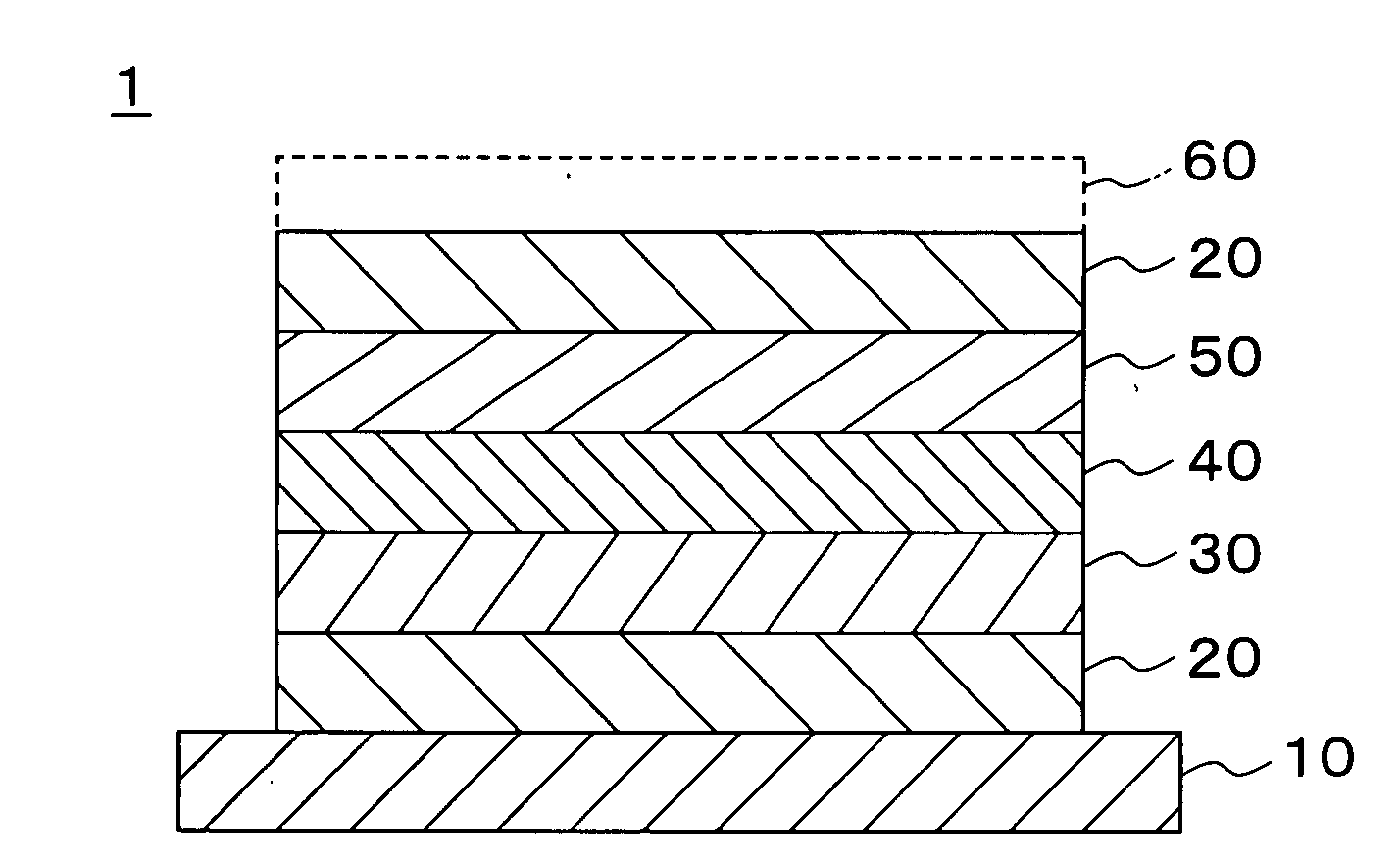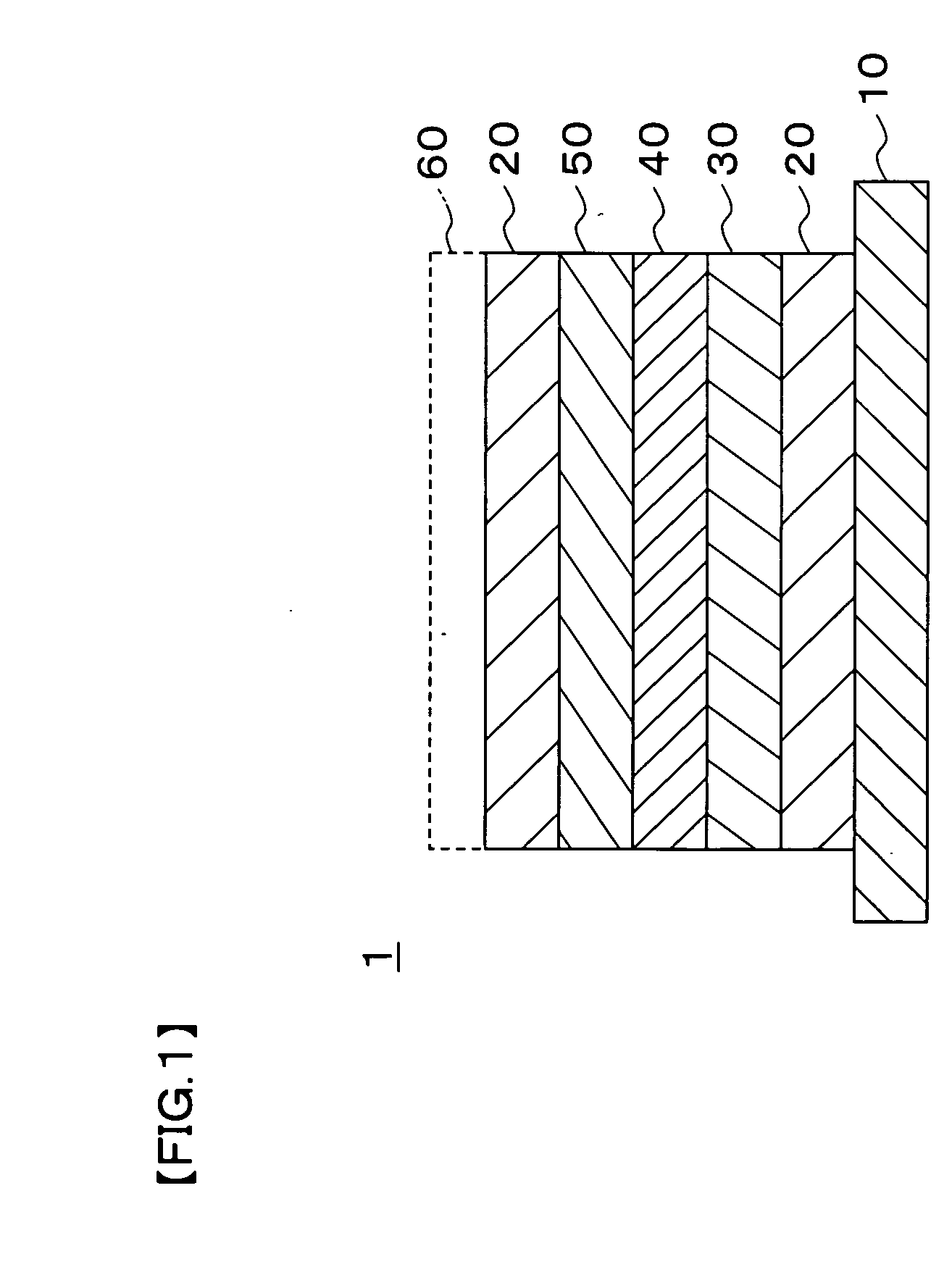Thin-Film Solid Secondary Cell
a thin film solid and secondary cell technology, applied in the field of thin film solid secondary cells, can solve the problems of inadequacies in advancing a further reduction in thickness or size, affecting the production efficiency of final products, and requiring formation time and formation cost, etc., to achieve excellent cell characteristics, stably created, and the effect of increasing the charge/discharge capacity
- Summary
- Abstract
- Description
- Claims
- Application Information
AI Technical Summary
Benefits of technology
Problems solved by technology
Method used
Image
Examples
example 1
[0056]In Example 1, a collector layer 20, a positive electrode active material layer 30, a solid electrolyte layer 40, a negative electrode active material layer 50, and the collector layer 20 were formed on a substrate 10 in this order by a sputtering method to provide a structure depicted in FIG. 1, thereby creating a thin-film solid secondary cell.
[0057]Soda lime glass having a vertical dimension of 100 mm, a lateral dimension of 100 mm, and a thickness of 1 mm was used for the substrate 10.
[0058]The collector layer 20 was formed by a DC magnetron sputtering method using a vanadium metal target. A DC power was 1 KW, and the film was formed without heating. As a result, a vanadium thin film of 0.3 μm was formed as the collector layer 20.
[0059]The positive electrode active material layer 30 was formed by an RF magnetron sputtering method using a sintered body target of a lithium manganate (LiMn2O4) and introducing oxygen. An RF power was 1 KW, and the film was formed without heatin...
example 2
[0068]In Example 2, a thin-film solid secondary cell having the structure depicted in FIG. 1 was created by a sputtering method. Layers other than a negative electrode active material layer 50 were formed with the same materials, the same film thicknesses, and the same film forming conditions as those in Example 1. The negative electrode active material layer 50 was formed by a DC magnetron sputtering method using an S—Mn alloy target at %). A DC power was 1 KW, and the film was formed without heating. As a result, an S—Mn alloy thin film of 0.3 μm was formed as the negative electrode active material layer 20.
[0069]In the following examples and comparative example, the same X-ray diffraction measurement as that in Example 1 was carried out, and the charge / discharge characteristics were measured under the same measurement conditions unless stated.
[0070]A diffraction peak did not appear in the X-ray diffraction measurement, and it was confirmed that all the constituent layers in the t...
example 3
[0077]In Example 3, a thin-film solid secondary cell having the structure depicted in FIG. 1 was created by a sputtering method. Layers other than a negative electrode active material layer 50 were formed with the same materials, the same film thicknesses, and the same film forming conditions as those in Example 1. The negative electrode active material layer 50 was formed by an RF magnetron sputtering method using a sintered body target of an indium oxide having tin added therein (ITO) and introducing oxygen. An RF power was 1 KW, and the film was formed without heating. As a result, an ITO thin film of 0.3 μm was formed.
[0078]A diffraction peak did not appear in the X-ray diffraction measurement, and it was confirmed that all the constituent layers in the thin-film solid secondary cell are amorphous.
[0079]In the measurement of the charge / discharge characteristics, it was confirmed that the thin-film solid secondary cell repeatedly demonstrates a charge / discharge operation. FIG. 4 ...
PUM
| Property | Measurement | Unit |
|---|---|---|
| electrode potential | aaaaa | aaaaa |
| volume | aaaaa | aaaaa |
| thickness | aaaaa | aaaaa |
Abstract
Description
Claims
Application Information
 Login to View More
Login to View More - R&D
- Intellectual Property
- Life Sciences
- Materials
- Tech Scout
- Unparalleled Data Quality
- Higher Quality Content
- 60% Fewer Hallucinations
Browse by: Latest US Patents, China's latest patents, Technical Efficacy Thesaurus, Application Domain, Technology Topic, Popular Technical Reports.
© 2025 PatSnap. All rights reserved.Legal|Privacy policy|Modern Slavery Act Transparency Statement|Sitemap|About US| Contact US: help@patsnap.com



